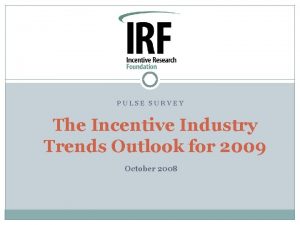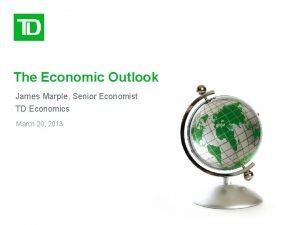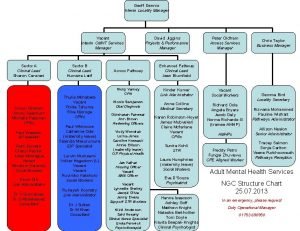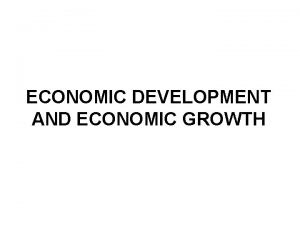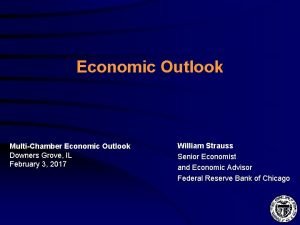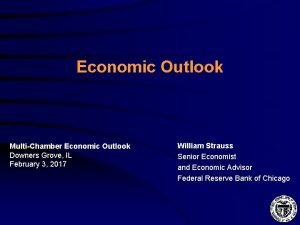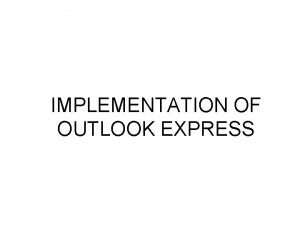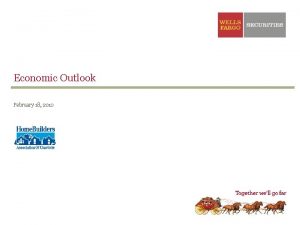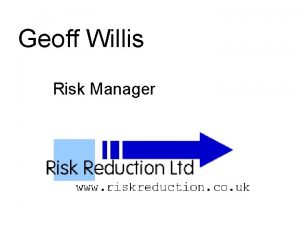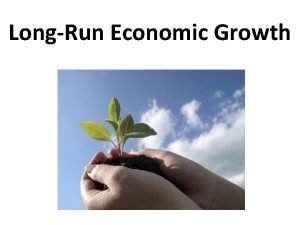Economic outlook for 2018 Geoff Tily Economic growth


















- Slides: 18

Economic outlook for 2018 Geoff Tily

Economic growth down but not out 3. 5 3 2. 5 2 1. 5 1 0. 5 0 -0. 5 2010 Q 1 2010 Q 2 2010 Q 3 2010 Q 4 2011 Q 1 2011 Q 2 2011 Q 3 2011 Q 4 2012 Q 1 2012 Q 2 2012 Q 3 2012 Q 4 2013 Q 1 2013 Q 2 2013 Q 3 2013 Q 4 2014 Q 1 2014 Q 2 2014 Q 3 2014 Q 4 2015 Q 1 2015 Q 2 2015 Q 3 2015 Q 4 2016 Q 1 2016 Q 2 2016 Q 3 2016 Q 4 2017 Q 1 2017 Q 2 2017 Q 3 2017 Q 4 per cent UK GDP growth Q on previous Q Q on year ago “The recovery has been driven by both the manufacturing and the service sectors, supported by the weaker pound a buoyant global economy, while construction output continues to lag. ” (NIESR)

0 -0. 5 Iceland Mexico Denmark United Kingdom Switzerland Italy Belgium Portugal Japan France NAFTA Israel Greece G 7 United States EU 28 Luxembourg Euro area (19 countries) Australia Norway OECD - Total OECD - Europe Germany Sweden Canada Finland Chile Spain Netherlands Slovak Republic Estonia New Zealand G 20 Austria Korea Hungary Poland Slovenia Ireland Czech Republic Latvia Turkey per cent Economic growth down but not out 2017 GDP average quarterly growth 2 1. 5 1 0. 5

2017 minus 2016, percentage pints -3 Iceland Ireland Mexico Israel Denmark Luxembourg United Kingdom Portugal Slovenia Australia Estonia Spain NAFTA New Zealand Slovak Republic Belgium G 20 EU 28 Netherlands Italy United States Euro area (19 countries) OECD - Total G 7 Switzerland Japan Finland Norway OECD - Europe Poland France Canada Germany Sweden Korea Hungary Austria Chile Turkey Greece Latvia Czech Republic Economic growth down but not out Change in average quarterly growth 1. 5 0. 5 1 -0. 5 0 -1 -1. 5 -2 -2. 5

Economic growth greatly down but not out

Factors likely to affect outcomes DEMAND SUPPLY POSITIVE • • World trade Lower inflation, ? higher real incomes • Weaker sterling NEGATIVE • • • Interest rate rises (global) QE withdrawn Ongoing austerity Brexit uncertainty Property Debt • Lack of capacity

World trade: “Broad- based upturn, but for how long? ” World Bank, Economic Prospects Report, January 2018 Source: World Bank

-5 2010 Q 1 2010 Q 2 2010 Q 3 2010 Q 4 2011 Q 1 2011 Q 2 2011 Q 3 2011 Q 4 2012 Q 1 2012 Q 2 2012 Q 3 2012 Q 4 2013 Q 1 2013 Q 2 2013 Q 3 2013 Q 4 2014 Q 1 2014 Q 2 2014 Q 3 2014 Q 4 2015 Q 1 2015 Q 2 2015 Q 3 2015 Q 4 2016 Q 1 2016 Q 2 2016 Q 3 2016 Q 4 2017 Q 1 2017 Q 2 2017 Q 3 2017 Q 4 World Trade: Impact on UK industries Industry growth, Q on year ago 15 10 5 0 -10 manufacturing construction services

World trade: weaker consumption, stronger trade UK, ppt contributions to growth Q on year ago 5 4 3 2 1 0 -1 -2 -3 -4 -5 Q 3 -2007 Q 3 -2008 Q 3 -2009 Q 3 -2010 Q 3 -2011 Q 3 -2012 Q 3 -2013 Q 3 -2014 Q 3 -2015 Q 3 -2016 Q 3 -2017 C G I X-M other Y

2010 Q 1 2010 Q 3 2011 Q 1 2011 Q 3 2012 Q 1 2012 Q 3 2013 Q 1 2013 Q 3 2014 Q 1 2014 Q 3 2015 Q 1 2015 Q 3 2016 Q 1 2016 Q 3 2017 Q 1 2017 Q 3 2018 Q 1 2018 Q 3 2019 Q 1 2019 Q 3 2020 Q 1 2020 Q 3 unemployment rate, per cent 9 6 8 5 7 6 5 4 0 3 -1 2 -2 1 0 2010 Q 1 2010 Q 3 2011 Q 1 2011 Q 3 2012 Q 1 2012 Q 3 2013 Q 1 2013 Q 3 2014 Q 1 2014 Q 3 2015 Q 1 2015 Q 3 2016 Q 1 2016 Q 3 2017 Q 1 2017 Q 3 2018 Q 1 2018 Q 3 2019 Q 1 2019 Q 3 2020 Q 1 2020 Q 3 Lower inflation, ? higher incomes Inflation and earnings growth, per cent 4 3 2 1 -3 -4 -5 CPI AWE real earnings

2010 Q 1 2010 Q 3 2011 Q 1 2011 Q 3 2012 Q 1 2012 Q 3 2013 Q 1 2013 Q 3 2014 Q 1 2014 Q 3 2015 Q 1 2015 Q 3 2016 Q 1 2016 Q 3 2017 Q 1 2017 Q 3 2018 Q 1 2018 Q 3 2019 Q 1 2019 Q 3 2020 Q 1 2020 Q 3 unemployment rate, per cent 9 8 7 6 4 3 2 -2 1 0 2010 Q 1 2010 Q 3 2011 Q 1 2011 Q 3 2012 Q 1 2012 Q 3 2013 Q 1 2013 Q 3 2014 Q 1 2014 Q 3 2015 Q 1 2015 Q 3 2016 Q 1 2016 Q 3 2017 Q 1 2017 Q 3 2018 Q 1 2018 Q 3 2019 Q 1 2019 Q 3 2020 Q 1 2020 Q 3 Lower inflation, higher incomes (NB RPI) Inflation and earnings growth, per cent 6 4 2 5 0 -4 -6 RPI CPI AWE real earnings Source: OBR

Interest rate rises / capacity 2018 is on track to be the first year since the financial crisis that the global economy will be operating at or near full capacity. World Bank By 2019, GDP growth is projected to ease mildly in the majority of major economies as capacity constraints begin to emerge, OECD Our models … tell a broadly consistent story of an economy operating close to potential. OBR, Nov. EFO p. 43 Unemployment has continued to fall and the extent of spare capacity in the economy now seems limited. Bo. E, Nov. 2017

Interest rate rises: but questions over inflation


(Global) QE withdrawn

Ongoing austerity

Factors likely to affect outcomes DEMAND SUPPLY POSITIVE • • World trade Lower inflation, ? higher real incomes • Weaker sterling NEGATIVE • • • Interest rate rises (global) QE withdrawn Ongoing austerity Brexit uncertainty Property Debt • Lack of capacity TOTAL MORE OF THE SAME: ONGOING HARDSHIP, FRAGILITY

 Economic growth vs economic development
Economic growth vs economic development Economic growth and development
Economic growth and development Outlook incentive outlook
Outlook incentive outlook Pldvs
Pldvs B a f c j e
B a f c j e Oecd economic outlook
Oecd economic outlook Td economic outlook
Td economic outlook Primary growth and secondary growth in plants
Primary growth and secondary growth in plants Difference between organic and inorganic growth
Difference between organic and inorganic growth Define growth analysis
Define growth analysis Chapter 35 plant structure growth and development
Chapter 35 plant structure growth and development Monocots vs eudicots
Monocots vs eudicots Geometric growth population
Geometric growth population Step growth polymerization vs chain growth
Step growth polymerization vs chain growth Neoclassical growth theory vs. endogenous growth theory
Neoclassical growth theory vs. endogenous growth theory Geoff petty
Geoff petty Geoff mason
Geoff mason Kavita deepak knights
Kavita deepak knights Geoff grenier
Geoff grenier


